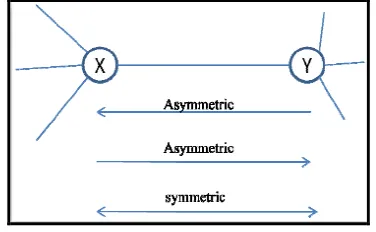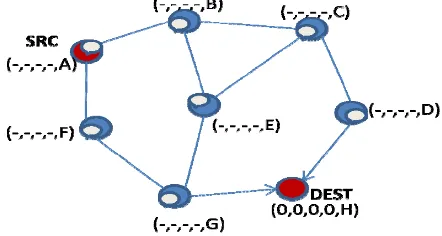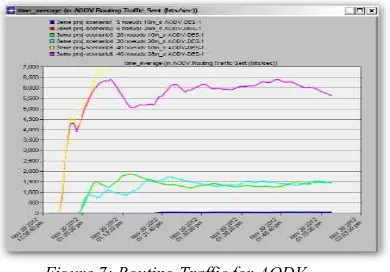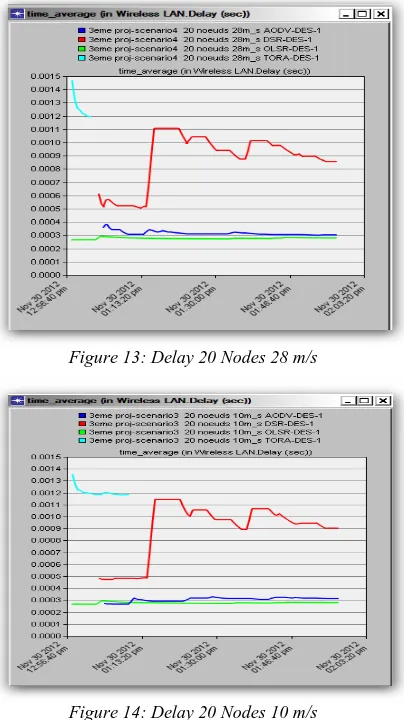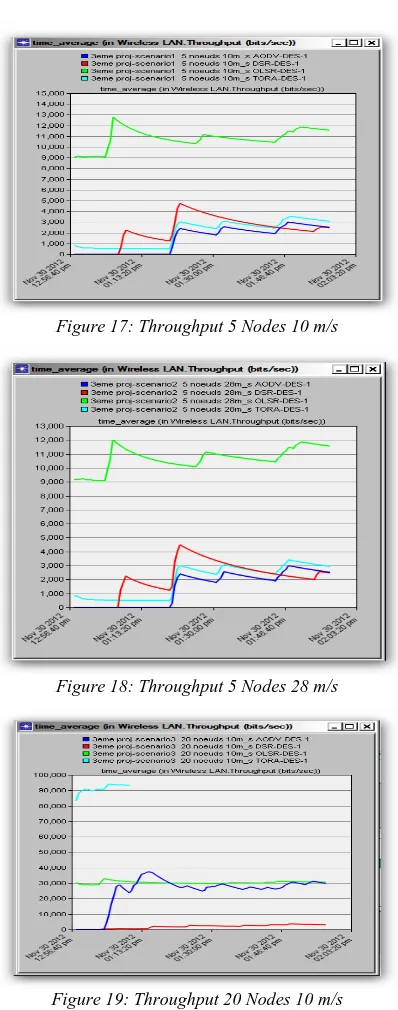QUALITY OF SERVICES ROUTING FOR MOBILE AD HOC
NETWORKS
1
ABDESSADEQ FETTOUH, 2ABDELAZIZ EL FAZZIKI, 3NAJIB EL KAMOUN
1 LISI Laboratory, FSSM Cadi Ayyad University, Marrakech
2 LISI Laboratory, FSSM Cadi Ayyad University, Marrakech
3
STIC Laboratory, Faculty of Science, Chouaib Doukkali University, El Jadida
E-mail: 1a.fettouh@skm.ma, 2elfazziki@ucam.ac.ma, 3elkamoun@gmail.com
ABSTRACT
The field of ad hoc networks is very promising since it allows the spontaneous creation of a network without any infrastructure. An ad hoc network consists simply of user terminals that can communicate together without intermediate. Simple and intuitive way of designing ad hoc networks is to consider that they correspond to the ultimate generalization of wireless networks because they limit the maximum role of fixed infrastructure. This generalization is achieved by improving the connectivity capabilities of wireless LANs. The limited scope of the terminals requires the presence of a routing protocol for communication between distant entities. Several routing protocols have been proposed in the MANET group. They allow finding the shortest paths in terms of number of hops. As Quality of Service (QoS) is an important issue in all networks (IT and telecom) , it seems interesting to study ways to introduce this concept in mobile ad hoc networks ( MANETs ) where the terminals are in movement relative to each other . In fact, multimedia applications that we know today require QoS guarantees more or less important that it would be good proposed in such still experimental networks. QoS can be provided at different levels: application layer, transport layer, network layer, MAC layer, etc. In this article, we focus on routing solutions to ensure a certain quality of service in mobile ad hoc networks at the network layer. To achieve this goal, many practical issues are considered with proposed solutions. We provided Quality of services of ad hoc networks by analyzing performance of different routing protocols. Different scenarios with the Network simulator OPNET are performed. The test-bed is first described, followed by the results and analysis. We concluded the paper with a summary of the key results of the work.
Keywords: Quality Of Services, Ambient Networks, MANET, AODV, OLSR, TORA.
1. INTRODUCTION
For wireless ad hoc networks, many layer tree routing protocols are developed, with competing functionalities. These protocols have varying qualities for different wireless routing types. It is due to this reason that choice of the adequate routing protocol is critical. In this paper, we handle three main questions. The first is ‘Which routing protocol furnishes the best performance in Mobile Ad hoc Networks?’ This question addresses the overall performance of each routing protocol investigated in this paper. The second question addresses the elements that impact the performance of these routing protocols. Finally yet importantly, we address the major differences in the routing protocols under study. To achieve this goal answering these questions, we modeled MANET scenarios by varying traffic loads and mobility scenarios and analyzed the performance of AODV,
DSR, OLSR and TORA with respect to throughput, packet delivery ratio, end-to-end delay and routing overhead. The principle in this paper is that no single routing protocol among AODV, DSR, OLSR and TORA super perform clearly the others. One protocol may be superior in terms of average end-to-end delay while another may perform better in terms of routing overhead and throughput. The performance of the routing protocol will greatly depend on various factors such as network load and mobility effects.
2. RELATED WORK
modes of operation envisaged network. Some ad hoc routing protocols such as CEDAR [3] have been specifically created to take this dimension into account. Nevertheless, the techniques used to ensure that QoS can cover all aspects of the transmission of information, including access to the media, the road reserve, managing queues, etc ... The appearance of this research coincides with a new use of computer networks. The former approach, called best effort or " best " (e.g. used by IP) does not guarantee the constraints expected by new multimedia services - including voice over Internet is a typical example - and therefore provides efficiency decreasing as these services develop.
Systems service quality usually involved in fighting against the erratic nature of the flow of packets exchanged. One reason is network congestion (saturation of bandwidth by a too large amount of information at the same time) which results in slowing or stopping certain flow at intermediate nodes. This fact leads to a loss of quality at the reception. The main mechanism is to adapt the operation of the network nature of the flows that must be processed. This implies on one hand it is possible to characterize the data flow passes on the other hand that the information on this classification is accessible nodes routers. We precede for example, through the implementation of contracts, reservation of bandwidth and memory in routers queuing to favor certain flows with significant time constraints. In [4], [5] and [6] particular models of quality of service for ad hoc networks have been developed.
3.
BACKGROUNDS
3.1 Ambient Networks
[image:2.612.322.510.503.619.2]Ambient Networks extend All-IP networks by several innovations. The extensions build on the demand for enabling communication between different social and economical realms as identified by the Internet research community. The three main innovations are network composition (beyond simple internetworking), enhanced mobility and effective support for heterogeneity in networks [14].
3.2 Quality of Service
It describes an important aspect of the formation and communication between ANs as well as legacy networks. Therefore QoS shall be guaranteed by the AN, even when composing with other ANs or interfacing to legacy networks. The ANI shall be able to communicate the parameters
needed at any one time for the establishment and maintenance of a service across and between any networks [13].
3.3 Routing Protocols
Routing protocols can be divided into two
categories, proactive protocols and reactive
protocols.
3.3.1. Proactive Protocols FSR, OLSR, DREAM, DSDV and Babel
This type of protocol is called proactive because the construction and verification of a route are still made even if it has no traffic to send. Updates to maintain the routing table is sent periodically. Among the advantages of this type is the availability of routes, making it easy to establish a session, but not forgetting the significant use of resources (memory, CPU ...).
OLSR is called proactive depending on its nature. Nodes that run using HELLO packets (see Figure 1) and TC(Topology Control) messages to discover their neighbors and maintain their routing tables. Each node uses a neighbor as MPR (Multi
Point Relay) to disseminate messages of
maintenance. The delay in a network running OLSR is too small; this is due to the availability of routes in the routing tables for each node. If X and Y are adjacent, X sends a HELLO message to Y, if it was well received, the connection is called Asymmetric, Y sends a HELLO message to X, if it is received becomes symmetric link. HELLO messages contain information about the neighbors (state ...). TC messages contain information about each MPR
selected any node.
Figure 1: OLSR - Exchange HELLO Messages
3.3.2. The Reactive Routing Protocols AODV, DSR and RDMAR
AODV(see Figure 2): As its name suggests, a route lookup in the application, it provides an adaptation to changes in routes and when a link fails, only nodes using it in their routes are notified of the break , which will allow them to ignore that the route through this link. The use of routing traffic is therefore minimized, since the routes are unicast from the source to the destination, we forget the minimized memory usage, no unnecessary route stored in the routing table. In Figure, if two nodes want to establish a connection, AODV builds paths in multi-hop nodes invoked a DSN number (Destination Sequence Number) is determined and used incremented at each node to avoid loops. When the source receives the response from the request, it uses the DSN to use the optimal route. The AODV protocol defines three messages RREQ: query routing, RREP: routing response and RERR: routing error. They are used to maintain the roads in the network between a source and a destination. Each time a source wants to communicate, it broadcasts a message PREQ. A route is determined whether the message reaches the next hop or the destination and the RREP message returned is received by the source. Each node that receives a PREQ saves routes from the source message. The rupture of a link causes a
RERR message contains information on
inaccessible and the IP addresses of nodes that use
[image:3.612.315.536.384.502.2]it as a jump to the destination nodes.
Figure 2: AODV Routing Protocol
3.3.3. Hybrid Routing Protocols Proactive locally + Reactive outside ZRP (Zone Routing Protocol) and TORA
TORA (Temporally Ordered Routing Algorithm) is an adaptive routing protocol; it is used in multi-hop networks. Between two nodes wanting to communicate technical TORA uses a DAG (Directed Acyclic Graph) to build a reliable route between them. It does not use the shortest
path algorithm, but it is based on four messages:
Query, Update, Clear and optimization.
DAG is performed by each node to send different parameters between the source and the destination node. The parameters include time to interrupt the link (t), the sender ID (oid), indication bit of reflection (r) sequence of frequencies (d) and the identifier of nodes (i). The first three parameters are called the baseline and the last two are the offset for the respective reference level. TORA constructed by the links are provided with a high value and the process starts from the top downwards. Initially, the value of all nodes is set to NULL or (-, -, -, -, i) and that the destination is set to (0, 0, 0, 0, Dest). The values are set whenever there is a change in the topology. A node needs a route to a destination sends a REQUEST message. A REQUEST packet has a destination node ID. When a REQUEST packet reaches a node with information about the destination node, a response known as UPDATE is sent on the reverse path. The UPDATE message defines the high value of neighboring nodes of the node that sent the UPDATE message. It also contains a destination field that indicates the destination.
Figure 3: TORA-Message Query
[image:3.612.91.297.453.600.2]
Figure 4: TORA-Message Update
TABLE 1:Comparison of Routing Algorithms.
3.4 Summary of the Existing Algorithms
Many algorithms have been proposed. If the similarities between some approaches appear, the methods developed are very diverse as desired optimizations. Table 1 provides a comparison of the routing protocols. We can assume that each protocol has its strengths and weaknesses. Some resist better example to increase network size. Other promotes rapid exchange of data. Still others bear more easily high mobility nodes. It is thus likely that the properties of the environment and prerequisites conditioned by the type of use are determinants in the choice of the most suitable protocol routing.
4.
SIMULATION
In this paper, we present the different parameters taken into consideration in the performance evaluation of routing protocols. We begin by defining the performance indicators included in the comparisons. We will then outline the scenarios simulation and analysis of each.
4.1 Evaluation Criteria
Various performance measures are used in the evaluation of routing protocols. They represent different characteristics of the overall network performance. In this report, we evaluate three parameters used in our comparisons to explore their impact on the overall network performance. These measures are routing traffic, throughput and delay.
4.1.1Routing Traffic
Routing traffic sent by each node, it is expressed in bits per second. Mobile ad hoc networks are designed to be scalable. As the
network grows, routing protocols operate
differently. Increased routing traffic changes with the development of networks. This traffic is defined as the total number of routing packets transmitted over the network, expressed in bits per second or packets per second.
4.1.2 Throughput
Transfer rate at a given time, it is expressed in bits per second. The factors that affect the throughput in the MANET are frequent
topology changes, communication, limited
bandwidth and limited energy. A broadband
network is desirable.
4.1.3 End-to-end Delay
end whether adapts to different network constraints, it also represents the reliability of the routing protocol.
4.2 Modeling and Scenarios 4.2.1 Scenarios
The following table 2 shows the 24 scenarios used in this simulation. Six scenarios for
each routing protocols, each scenario is
characterized by either a change in the rate of mobility of the number of nodes
TABLE 2:SIMULATION Scenarios
4.2.2 Modeling
Our goal is to model the behavior of routing protocols under different conditions of load and speed mobility. We collected comprehensive statistics (DES) for each protocol and wireless LAN. We examined the statistical averages of throughput, delay, and traffic routing for the entire MANET.
We modeled a campus network with an area 1 km x 1 km. Mobile nodes and the server were randomly assigned to the geographic area. In the simulations, the mobile nodes receive traffic from a common source (here ftp server). In this work, we used the TCP traffic to study the effects of ad hoc protocols. This will allow an assessment of the performance of protocols in TCP -based applications such as web and file transfer. We configured a profile FTP application to our study. WLAN nodes are mobile customers with a flow rate set to 11 Mbps operating at a power of 0,005 watts. The destination server is a wireless local area network also with a data rate of 11 Mbps and the transmission power with 0.005 watts. We used the subject of mobility to define the Random Waypoint mobility model used in the simulations. It is a model of simple and widely accepted to describe mobility behavior more realistic mobility. The nodes are moving at a constant speed according to the table 1 above. When the node reaches its destination, it stops for 300 seconds, and then chooses a new destination at random.
4.2.3 Selection of Statistics
There are two kinds of statistics, the object statistics and global statistics that can be collected in OPNET. The global statistics are collected from the entire network while statistics concerning the subject individual nodes. When the desired statistics are selected, we must run the simulation to record statistics. After running the simulation, the results obtained are shown and analyzed. This is done either by right-clicking in
Figure 5: Results Selection
the workspace of the project editor and choosing «show results» or by clicking on "DES», "view results «and» results" as shown in Figure 5.
5.
RESULTS AND ANALYSIS
scenario
Number ofNodes
Mobility M / S
OLSR
Scenario1 5 10
Scenario2 5 28
Scenario3 20 10
Scenario4 20 28
Scenario5 40 10
Scenario6 40 28
AODV
Scenario1 5 10
Scenario2 5 28
Scenario3 20 10
Scenario4 20 28
Scenario5 40 10
Scenario6 40 28
TORA
Scenario1 5 10
Scenario2 5 28
Scenario3 20 10
Scenario4 20 28
Scenario5 40 10
Scenario6 40 28
DSR
Scenario1 5 10
Scenario2 5 28
Scenario3 20 10
Scenario4 20 28
Scenario5 40 10
In this section, we discuss and analyze the results of our simulations. We begin our discussion with an analysis of routing traffic in the network. We will then analyze the end-to-end delay and finally the network throughput.
[image:6.612.318.520.84.414.2]5.1 Routing Traffic
Figure 6: Routing Traffic for DSR
In Figure 6 for DSR, we note that in the case of 5 nodes, mobility does not affect traffic, with 40 nodes and 28 m / s the traffic is almost coherent whereas it decreased at the beginning to 10 m / s and then increased. As mobility increases, links may experience disruptions (nodes pause ...), forcing DSR to react frequently, and generating traffic. Regarding AODV in Figure 7, same thing, mobility have no influence in the case of 5 and 20 nodes,
Figure 7: Routing Traffic for AODV
[image:6.612.92.294.165.342.2]with 40 nodes and 10 m / s the coherent against traffic we see in the beginning to 28 m / s it is less then increases. Mobility affects AODV when it increases, causing connection failures which makes recovery difficult.
Figure 8: Routing Traffic for TORA
Figure 9: Routing Traffic for OLSR
5.2 The End-to-end Delay
[image:6.612.95.290.472.608.2]discovery.
[image:7.612.94.303.76.475.2]Figure 11: Delay 5 Nodes 28 m/s
Figure 12: Delay 5 Nodes 10 m/s
AODV also has a very low latency and comes second after OLSR. This is observed in all scenarios, except in the case of reducing the number of nodes and high speed where it outperforms TORA. However, we observe that the AODV performance improves with increasing number of sources. Initiation jump in AODV reduces the time end- to-end. DSR shows a uniform period for both low and high speed networks with 5 and 20 nodes. With the network of 50 traffic sources, time DSR increases in both nobilities. DSR uses cached routes and most often, it sends the traffic on the roads obsolete, which can cause retransmissions and creates excessive delays. Thus, in networks with high traffic sources, increasing the number of connections cached worse time. On the other hand, attempts to minimize the DSR effect through the use of obsolete multipath routes. We observe that OLSR exhibits a very low period in all scenarios. TORA with a high in the network with high traffic time, and mobility had no effect on
[image:7.612.321.523.192.552.2]the delay. AODV has a better time when the network increases as the speed had no effect on his time, and finally DSR has a consistent approach to time and suffered further delay when the network expands, but the speed n has no profound effects on its performance. The three reactive protocols had elevated to higher costs due to the increased demand route discovery delays.
Figure 13: Delay 20 Nodes 28 m/s
Figure 14: Delay 20 Nodes 10 m/s
As shown in Figures 11, 12, 13, 14, 15 and 16 AODV performs best in networks with a relatively high number of traffic and high-speed mobility. OLSR has a constant flow in the case of two-speed mobility. As described above, OLSR is a proactive protocol manages the consistent routing tables offering a delay as coherent. The flow is a function of the delay and traffic routing, a coherent flow was expected. This demonstrates the overall superiority of OLSR. It should be noted that if the network grows, OLSR routing tables can become too large, by coupling it to congestion and other problems in wireless networks, we can see an
overall degradation of performance.
coherent any speed mobility. This is consistent with an increase in flow in parallel with the expansion of the network. If the network grows fast, TORA may lose its performance since its algorithm (DAG) depends on the number of initial nodes.
Figure 15: Delay 40 Nodes 10 m/s
[image:8.612.100.290.165.455.2]
Figure 16: Delay 40 Nodes 10 m/s
5.3 The Throughput
From Figure 17 through 22, we observe that OLSR outperforms all other protocols in all scenarios. As OLSR is a proactive routing protocol, the paths are readily available for traffic. OLSR maintains consistent paths in the network leading to a low delay. A small delay in the network reflects a higher throughput.
In the network with five sources of traffic, DSR outperforms AODV and TORA 10 m / s and 28 m / s even if it has a high delay. This difference can be explained by observing the routing overhead. DSR generates less traffic routing. As the network is small, the prevalence of broken links and other factors are not much in. Therefore, the flow rate is a factor of routing traffic that the delay in the case of small systems. DSR is experiencing performance degradation in networks of large sizes (20 and 40 knots); this is due to the problem of
congestion and broken links, forcing it to respond frequently to adapt to change. DSR is outperforms AODV and TORA in the case of small networks at any speed mobility. As against the TORA outperforms when the network grows. AODV has a higher throughput when nodes are moving at a slower speed in the network with a small number of nodes, then it has a higher rate in the case of a
higher speed mobility networks larger.
[image:8.612.319.518.197.702.2]
Figure 17: Throughput 5 Nodes 10 m/s
Figure 18: Throughput 5 Nodes 28 m/s
[image:8.612.103.293.341.500.2]Figure 20: Throughput 20 Nodes 28 m/s
Figure 21: Throughput 40 Nodes 10 m/s
[image:9.612.312.520.79.267.2]AODV performs best in networks with a relatively high number of traffic and high-speed mobility. OLSR has a constant flow in the case of two-speed mobility. As described above, OLSR is a proactive protocol manages the consistent routing tables offering a delay as coherent. The flow is a function of the delay and routing traffic, a coherent flow was expected. This demonstrates the overall superiority of OLSR. It should be noted that if the network grows, OLSR routing tables can become too large, by coupling it to congestion and other problems in wireless networks, we can see an overall degradation of performance. TORA, in the case of fewer nodes, the flow is coherent any speed mobility. This is consistent with an increase in flow in parallel with the expansion of the network. If the network grows fast, TORA may lose its performance since its algorithm (DAG) depends on the number of initial nodes.
Figure 22: Throughput 40 Nodes 28 m/s
5.4 Analysis and Conclusion
Simulation results have shown that the factors considered in this paper that can affect the performance of ad hoc protocols, are speed and network load. This shows that MANET provides the intended solution to the need for mobility by wireless nodes. Network load has a profound effect on performance, while the speed does not affect the performance in some cases. Although AODV and OLSR are very different nature, are very similar in terms of performance. In a highly mobile network, with frequent topology change, AODV has a small advantage over OLSR because the routes are updated faster. OLSR must wait several Hello packets lost before changing the state of the link and send information to update. By cons, in a static network, OLSR clutters least the network than
AODV that transmits more messages to each route
discovery. Indeed, in this case OLSR hardly emits message updates to the topology.
In general, proactive protocols have good results in the case of large networks, while reactive protocols have better performance in low capacity networks. AODV and OLSR have shown the best delay, therefore they can be evaluated in the future works, but with a different type of application, which takes delay as a key factor, it is real Time applications. A performance comparison of ad hoc routing protocols in MANETs and in mobile LTE would help ascertain how well mobile LTE has addressed the mobility problem.
The other alternative direction of this research will explore the feasibility of developing a new algorithm that will address the limitations that the ad hoc routing protocols evaluated in this research pose. For example, OLSR is superior to
theother routing protocols in many aspects such as
the network with routing traffic for discovery and maintenance even when a link is not in use.
REFRENCES:
[1] E.Crawley, R. Nair, B. Raja Gopalan and H. Sandick, “A framework for QoS based routing in the internet”, RFC 2386, Mobile Ad Hoc
Networking Working Group, Aout 1998.
[2] Rabah Meraihi, “Managing quality of services and topology control in ad hoc networks”, PhD
thesis, National High School of
telecommunications, 2005.
[3] Prasun Sinha, Raghupathy Sivakumar and Vaduvur Bhargha van CEDAR, “a
core-extraction distributed ad hoc routing algorithm”
In INFOCOM (1), 1999, pages 202–209.
[4] H. Xiao, W. Seah, A. Lo and K. Chua, “A flexible quality of service model for mobile ad-hoc networks”, In IEEE Vehicular Technology
Conference, May 2000, pages 445–449.
[5] K. Chen, S. H. Shah and K. Nahrstedt, “Cross-layer design for data accessibility in mobile ad
hoc networks”, Journal on Wireless
Communications, 2002, 21:49–75.
[6] Seoung-Bum Lee, Gahng-Seop Ahn, Xiaowei Zhang and Andrew T. Campbell, “INSIGNIA: An IP-based quality of service framework for mobile ad hoc networks”, Journal of Parallel
and Distributed Computing, 2000, 60(4):374–
406.
[7] Valeri Naoumov and Thomas Gross,
“Simulation of large ad hoc networks”, In Sixth
ACM International Workshop on Modeling, Analysis and Simulation of Wireless and Mobile Systems (MSWiM 2003), September 2003.
[8] Sanjay P. Ahuja and Renato Quintao, “Simulation comparison of four wireless ad hoc
routing protocols” In IEEE Vehicular
Technology Conference (VTC 2000), May 2000.
[9] J. Broch, D.A. Maltz, D.B. Johnson Y.C. Hu and J. Jetcheva, “A performance comparison of multi-hop wireless ad hoc network routing protocols”, In Fourth Annual ACM/IEEE
International Conference on Mobile Computing and Networking, October 1998.
[10] Samba Sesay, Zongkai Yang, Biao Qi and Jianhua He, “A performance comparison of multi-hop wireless ad hoc network routing protocols” Information Technology Journal, 2004, 3.
[11] David B Johnson and David A Maltz, “Dynamic source routing in ad hoc wireless networks”, In Imielinski and Korth, editors,
Mobile Computing Kluwer Academic
Publishers, 1996, volume 353.
[12] J.P. Macker and M.S. Corson, “Mobile Ad hoc
Networking (MANET) Routing Protocol
Performance Issues and Evaluation
Considerations”, RFC 2501, IETF: The Internet
Engineering Task Force, http: //www.ietf.org,
January 1999.
[13] D. Johnson, C. Perkins and J. Arkko “Mobility Support in IPv6”, RFC IETF 3775, June 2004.
[14] Nazia Jamil, “Architecture of Ambient
Network” Telecommunication Engineering,
15th November, 2006. P87362. Protocol Conclusion
OLSR
• OLSR outperforms AODV, DSR and
TORA in Throughput and end-to-end
delay.
• OLSR has the worst performance in routing traffic generated. It is
therefore well suited for high speed
networks. High routing traffic shows
that OLSR discovers and maintains
the roads, which makes it unsuitable
for low capacity.
DSR
• DSR is the best candidate for the low capacity networks.
• However, it has a large routing traffic in the case of long path (large
networks). It inserts in the packet IP
addresses of all nodes in the route it
uses. Therefore, the use of DSR in
networks with IPv6 addressing is a
result of higher routing traffic.
AODV
• AODV networks suitable for low and medium load with low speed
mobility.
• Undesirable when the mobility increases and the Network extends
(high routing traffic)
TORA
• TORA Suitable for small network. • Loses its performance in case of
